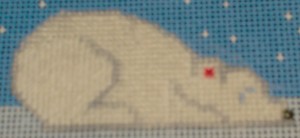
What stitch should I use for my background? I’m always getting this question and, I admit, it often perplexes me when stitching my own canvases. I’m working on this one now and have no idea what to use for the background.
It doesn’t have to be hard because if you remember some guidelines and have a few great stitches in mind, you’ll have some stellar backgrounds to pull out of you hat.
The Guidelines
Backgrounds should always be less flashy than the rest of the canvas. Look for lower or more open stitches. Pick threads that don’t attract attention.
Thinner threads can accomplish much in backgrounds. One way to make your background recede is to use thinner threads. These will automatically be lower than the thicker threads in your focal point.
Backgrounds stitches should fit the size of the background. They need to have three or more repeats in all directions.
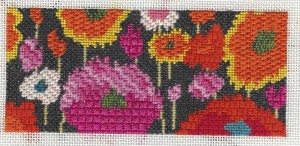
Background stitches should not have too much compensation. A canvas with lots of small areas and/or ins & outs, above, will need a smaller background stitch than a canvas with a clean outline, below.

Some Great Slightly Open Stitches
I love to play with exploding regular needlepoint stitches to create ones that are open and show some unstitched canvas. Not only does this add the background color as an element in the finished piece, these stitches can create great patterns for backgrounds that still stay lower and behind the main stitch.
Here are some great choices:
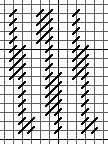
Cascading Cashmeres: This stitch takes Diagonal Cashmere and spaces it out with some Tent Stitches. Its great feeling of movement happens because the Cashmeres in each row move down in a gentle slope. It’s an outstanding background for underwater scenes.
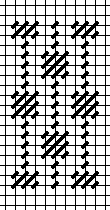
Scotch on a String: Another open stitch using a Box Stitch as its base. Tent Stitches connect the individual squares in a nice half-drop pattern. While this background is great for many canvases, try it on a Mid-Century Modern piece, it will reinforce those elements.
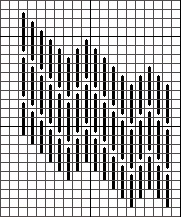
Skip-a-row Stitches Any stitch that is in rows, straight or not, can be opened by leaving one or more threads open between rows. With one row open you almost don’t notice the color of the canvas — it’s just a break (like grout in tile). Leave more threads open and the canvas becomes a stronger visual element.
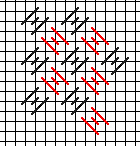
Diagonal H This is an small open stitch where units slant in both directions. That makes it an excellent choice when you don’t want to background to have an obvious direction. it can be hard to compensate though, so don’t use it on fiddly canvases.

Background Stitch For years I thought the name of this stitch was weird: How can any stitch be so great for backgrounds that it deserves this name? This one, an exploded Four-way Continental, does. it is too open to work for textured areas. It makes great backgrounds for any kind of canvas, large or small because it so unassuming. I just love it!
About Janet M Perry
Janet Perry is the Internet's leading authority on needlepoint. She designs, teaches and writes, getting raves from her fans for her innovative techniques, extensive knowledge and generous teaching style. A leading writer of stitch guides, she blogs here and lives on an island in the northeast corner of the SF Bay with her family

GREAT INFORMATION RE OPEN STITCHES. THANK YOU. ARE THERE OTHER RULES, EXAMPLES, GOOD PUBLICATIONS?
Watch for a blog post with books & resources for this on Wednesday.
Keep stitching,
Janet